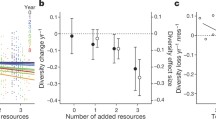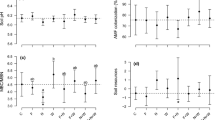Abstract
The capture and efficient use of limiting resources influence the competitive success of individual plant species as well as species diversity across resource gradients. In simulations, efficient nutrient acquisition or nutrient retention by species were key predictors of success when nutrients were limiting. Increased nutrient supply favored species with characteristics that improved light interception or light use. Ecological theory suggests that low diversity on fertile sites may be a consequence of competitive exclusion by one or a few species with superior light-interception characteristics. On infertile sites, competitive exclusion may be a function of superior nutrient-acquisition characteristics in species. At intermediate fertility, a shift from single-resource specialization to a balanced effort in the acquisition of multiple resources should allow for greater species diversity. Thus, a unimodal relationship between diversity and nutrient supply, vegetation biomass, or productivity is predicted. However, simulations demonstrated alternate relationships depending on the ecosystem characteristic to which diversity was compared. Diversity was greatest at intermediate total biomass but increased monotonically with net primary production and nitrogen (N) supply. The highest diversity occurred midrange on a scale of community-level leaf area to fine-root length ratios, which in the context of the model indicates that the vegetation as a whole was simultaneously limited by both N and light and that effort toward the acquisition of both resources is distributed in such a way that both resources are equally exploited. Diversity was lowered by the presence of species with a superior ability to sequester resources.







Similar content being viewed by others
References
PA Abrams (1988) ArticleTitleHow should resources be counted? Theor Popul Biol 33 226–42
PA Abrams (1995) ArticleTitleMonotonic or unimodal diversity–productivity gradients: what does competition theory predict? Ecology 76 2019–27
RE Aerts (1990) ArticleTitleNutrient use efficiency in evergreen and deciduous species from heathlands. Oecologia (Berl) 84 391–7
RE Aerts FS Chapin III (2000) ArticleTitleThe mineral nutrition of wild plants revisited : a re-evaluation of processes and patterns. Adv Ecol Res 30 1–67 Occurrence Handle1:CAS:528:DC%2BD3cXivVejurw%3D
MM Al-Mufti CL Sydes SB Furness JP Grime SR Band (1977) ArticleTitleA quantitative analysis of shoot phenology and dominance in herbaceous vegetation. J Ecol 65 759–91
AJ Bloom FS Chapin III HA Mooney (1985) ArticleTitleResource limitation in plants: an economic analogy. Annu Rev Ecol Syst 16 363–92
FS Chapin III (1980) ArticleTitleThe mineral nutrition of wild plants. Annu Rev Ecol Syst 11 233–60 Occurrence Handle1:CAS:528:DyaL3MXivFagug%3D%3D
JE Connell E Orias (1964) ArticleTitleEcological regulation of species diversity. Am Nat 98 399–414 Occurrence Handle10.1086/282335
JE Connell RO Slatyer (1977) ArticleTitleMechanisms of succession in natural communities and their role in community stability and organization. Am Nat 111 1119–44 Occurrence Handle10.1086/283241
DJ Currie (1991) ArticleTitleEnergy and large-scale patterns of animal- and plant-species richness. Am Nat 137 27–49 Occurrence Handle10.1086/285144
Darwin C. 1872. The origin of species. 6th London ed. Chicago: Thomas and Thomas.
CS Elton (1958) The ecology of invasions by animals and plants. Methuen London
AE Giblin KJ Nadelhoffer GR Shaver JA Laundre AJ McKerrow (1991) ArticleTitleBiogeochemical diversity along a riverside toposequence in arctic Alaska. Ecol Monogr 61 415–35
L Gough JB Grace KL Taylor (1994) ArticleTitleThe relationship between species richness and community biomass: the importance of environmental variables. Oikos 70 271–9
JB Grace (1993) ArticleTitleThe effect of habitat productivity on competition intensity. Trends Ecol Evol 8 229–30 Occurrence Handle10.1016/0169-5347(93)90194-T
JB Grace (1999) ArticleTitleThe factors controlling species density in herbaceous plant communities: an assessment. Perspect Plant Ecol Evol Syst 2 1–28
JP Grime (1973a) ArticleTitleCompetition and diversity in herbaceous vegetation: a reply. Nature 244 310–11
JP Grime (1973b) ArticleTitleControl of species diversity in herbaceous vegetation. J Environ Manage 1 151–67
JP Grime (1979) Plant strategies and vegetation processes. John Wiley and Sons Chichester (UK)
Q Guo WL Berry (1998) ArticleTitleSpecies richness and biomass: dissection of the hump-shaped relationships. Ecology 79 2555–9
LO Hedin JJ Armesto AH Johnson (1995) ArticleTitlePatterns of nutrient loss from unpolluted, old–growth temperate forests: evaluation of biogeochemical theory. Ecology 76 493–509
DA Herbert EB Rastetter GR Shaver GI Ågren (1999) ArticleTitleEffects of plant growth characteristics on biogeochemistry and community composition in a changing climate. Ecosystems 2 367–82 Occurrence Handle10.1007/s100219900086 Occurrence Handle1:CAS:528:DyaK1MXmtlyjtbg%3D
MA Huston (1994) Biological diversity Cambridge University Press Cambridge
MA Huston DL DeAngelis (1994) ArticleTitleCompetition and coexistence: the effects of resource transport and supply rates. Am Nat 144 954–77 Occurrence Handle10.1086/285720
FW Lesack JM Melack (1991) ArticleTitleThe deposition, composition and potential sources of ionic solutes in rain of the central Amazon basin. Water Resour Res 27 2953–77 Occurrence Handle10.1029/91WR01946 Occurrence Handle1:CAS:528:DyaK38XksFyhtw%3D%3D
GM Lovett KC Weathers W Sobczak (2000) ArticleTitleNitrogen saturation and retention in forested watersheds of the Catskill Mountains, NY. Ecol Appl 10 73–84
RH MacArthur (1955) ArticleTitleFluctuation of animal populations and a measure of community stability. Ecology 36 533–6
R Margalef (1963) ArticleTitleOn certain unifying principles in ecology. Am Nat 97 357–74 Occurrence Handle10.1086/282286
A Magurran (1988) Ecological diversity and its measurement Princeton University Press Princeton
RH Marrs JB Grace L Gough (1996) ArticleTitleOn the relationship between plant species diversity and biomass: a comment on a paper by Gough, Grace and Taylor. Oikos 75 323–6
GG Mittelbach CF Steiner SM Scheiner KL Gross HL Reynolds RB Waide MR Willig SI Dodson L Gough (2001) ArticleTitleWhat is the observed relationship between species richness and productivity? Ecology 82 2381–96
M Monsi T Saeki (1953) ArticleTitleÜber den Lichtfaktor in den Pflanzengesellschaften und seine Bedeutung für die Stoffproduktion. Jpn J Bot 14 22–52
H Olff J Huisman BF Van Tooren (1993) ArticleTitleSpecies dynamics and nutrient accumulation during early primary succession in coastal sand dunes J Ecol 81 693–706
FW Preston (1962) ArticleTitleThe canonical distribution of commonness and rarity. Ecology 43 185–215
EB Rastetter GI Ågren (2002) ArticleTitleChanges in individual allometry can lead to species coexistence without niche separation. Ecosystems 5 789–801 Occurrence Handle10.1007/s10021-002-0188-3
EB Rastetter GI Ågren GR Shaver (1997) ArticleTitleResponses of N-limited ecosystems to increased CO2: a balanced-nutrition, coupled-element-cycles model. Ecol Appl 7 444–60
EB Rastetter GR Shaver (1992) ArticleTitleA model of multiple-element limitation for acclimating vegetation. Ecology 73 1157–74
EB Rastetter PM Vitouse C Fiel GR Shave D Herbert GI Ågren (2001) ArticleTitleResource optimization and symbiotic N fixation. Ecosystems 4 369–88 Occurrence Handle1:CAS:528:DC%2BD3MXltlKjsb0%3D
RJ Reader SD Wilson JW Belcher I Wisheau PA Keddy D Tilman EC Morris JB Grace JB McGraw H Olff et al. (1994) ArticleTitlePlant competition in relation to neighbor mass: an intercontinental study with Poa pratensis. Ecology 75 1753–60
ML Rosenzweig Z Abramski (1993) How are diversity and productivity related? RE Ricklefs E Schluter (Eds) Species diversity in ecological communities: historical and geographical perspectives University of Chicago Press Chicago 52–65
TW Schoener (1976) ArticleTitleAlternatives to Lotka–Volterra competition: models of intermediate complexity. Theor Popul Biol 10 309–33 Occurrence Handle1:STN:280:CSiC3crislQ%3D Occurrence Handle1013908
RR Sokal FJ Rohlf (1980) Biometry: the principles and practice of statistics in biological research. 2nd ed. WH Freeman New York
D Tilman (1982) Resource competition and community structure Princeton University Press Princeton
D Tilman (1987) ArticleTitleSecondary succession and the pattern of plant dominance along experimental nitrogen gradients. Ecol Monogr 57 189–214 Occurrence Handle1:STN:280:Bi6D2c%2FlvFA%3D
D Tilman (1990) ArticleTitleConstraints and tradeoffs: toward a predictive theory of competition and succession. Oikos 58 3–15
D Tilman (1997) ArticleTitleDistinguishing between the effects of species diversity and species composition. Oikos 80 185
D Tilman S Pacala (1993) The maintenance of species richness in plant communities. RE Ricklefs D Schluter (Eds) Species diversity in ecological communities: historical and geographical perspectives University of Chicago Press Chicago 13–25
D Tilman D Wedin (1991) ArticleTitlePlant traits and resource reduction for five grasses growing on a nitrogen gradient. Ecology 72 685–700
PM Vitousek (1982) ArticleTitleNutrient cycling and nutrient use efficiency. Am Nat 119 553–72 Occurrence Handle10.1086/283931
RB Waide MR Willig CF Steiner GG Mittelbach L Gough SI Dodson GP Juday R Parmenter (1999) ArticleTitleThe relationship between primary productivity and species richness. Annu Rev Ecol Syst 30 257–300 Occurrence Handle10.1146/annurev.ecolsys.30.1.257
D Wedin D Tilman (1993) ArticleTitleCompetition among grasses along a nitrogen gradient: initial conditions and mechanisms of competition. Ecol Monogr 63 199–229
SD Wilson D Tilman (1991) ArticleTitleComponents of plant competition along an experimental gradient of nitrogen availability. Ecology 72 1050–8
SD Wilson D Tilman (1995) ArticleTitleCompetitive responses of eight old-field plant species in four environments. Ecology 76 1169–80
K Zobel J Liira (1997) ArticleTitleA scale-independent approach to the richness vs biomass relationship in ground-layer plant communities. Oikos 80 325–32
Acknowledgements
National Science Foundation grant DEB95-09613 provided funding support for this research. We thank Bonnie Kwaitkowski for assistance in development of the MEL model and Jim Grace for substantive comments on the manuscript.
Author information
Authors and Affiliations
Corresponding author
Appendices
Appendix 1. Model Equations, Variables, and Parameters.































Table 3
Appendix 2
Rights and permissions
About this article
Cite this article
Herbert, D., Rastetter, E., Gough, L. et al. Species Diversity Across Nutrient Gradients: An Analysis of Resource Competition in Model Ecosystems . Ecosystems 7, 296–310 (2004). https://doi.org/10.1007/s10021-003-0233-x
Received:
Accepted:
Published:
Issue Date:
DOI: https://doi.org/10.1007/s10021-003-0233-x




